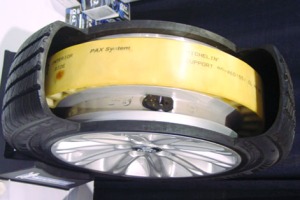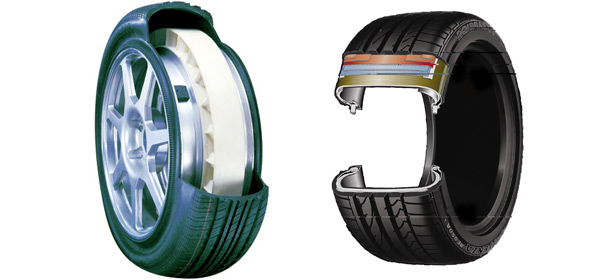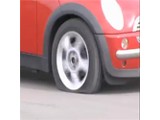|
Most everyone dreads a flat tire. Not only are they inconvenient, but drivers who haven't experienced a blowout at speed wonder how they'd react. And no one likes the idea of being stuck at the side of a busy road in nice clothes with an unplanned dirty job to do. Run-flat or zero-pressure tires are intended to support the weight of the car for a short time, providing the driver with 100 or so miles of range to get off the highway and find a repair shop. Sounds like a slam-dunk no-brainer, right? But is it really that simple? The players Two kinds of zero-pressure tires exist in the market today. Both types still require the usual amount of air to provide day-to-day performance. Self-supporting tires (SSTs) are the original and most common run-flat type. Heavily reinforced sidewalls support the vehicle after air departs the scene. This sort of run-flat is designed to fit on normal wheels with no modifications. 
Michelin's PAX, a patented auxiliary support run-flat system, is a relative newcomer. PAX sidewalls, while still stiffer than normal tires, are not as rigid as SSTs. Instead Michelin designed a unique wheel that positions a semi-rigid "support ring" inside the tire to hold the car up when the air goes bye-bye. A non-standard bead design is necessary where wheel and tire meet. Enter TPMS A side effect of the stiff sidewalls found on run-flats is that they never look flat. As a result, the danger of driving on underinflated tires is even greater, as many people don't check their tire pressures until they "look" low. To counter this problem, the use of tire-pressure monitoring systems (TPMS) has become mandatory in run-flat applications. Since run-flats only provide a limited zero-pressure driving range, TPMS is critical to help the driver know when the mileage clock starts ticking, and more importantly, when time is up. The good
The bad
The irony TPMS is such a good idea that the federal government has made it mandatory for all cars, not just those with run-flats. Twenty percent of 2006 vehicles have it, increasing to 70 percent in 2007 and 100 percent in 2008. Ironically, TPMS makes the case for run-flats less compelling. Since these systems excel at alerting drivers to underinflation and slow leaks before they can fester and weaken a tire, the likelihood of certain types of blowouts and flat tires is reduced. In making the case for mandatory TPMS, the NHTSA cited tire industry data claiming that 85 percent of tire deflations are slow leaks — some of which go unnoticed and end up as blowouts. The remaining 15 percent are due to sudden ruptures or large punctures. Other industry sources put the sudden rupture percentage even lower than 15 percent. You have to decide Run-flats work as advertised, but they have unspoken downsides that everyone needs to be aware of. Cost and availability may improve over time, but that depends on how customers react to the prospect of no spare, a potentially harder ride and reduced replacement choices. In the short term, higher replacement costs and supply issues are the reality. TPMS is soon to be a standard-equipment fact of life on cars without run-flats. These systems are being implemented to reduce the likelihood of the very thing that run-flat tires were designed to address: the blowout and roadside stranding. Your own personal feelings, budget, driving patterns and geographical circumstances need to be figured in the decision to go with run-flats or not. For some of us, the decision is not as easy as it first sounds.
[cite: edmunds] |
    |
Run Flat Tires Explained for MINI Coopers
Question:
Do you sell Run Flat Tires?
Answer:
Great question. No we don't sell Run Flat tires. Nor do we sell standard tires for you MINI. It's much cheaper for you to buy those at a designated tire store. But... should you decide to change from a Run Flat Tire to a Standard Tire, don't forget you'll need a emergency spare tire. And those we do sell. You can find them here, on our Spare Tire page .
Hope that helps.
Mini Mania Tech Support
Hope that helps.
Mini Mania Tech Support
9 Comments
Let's make sure we're showing you the right parts! Please Select your car type Below:









